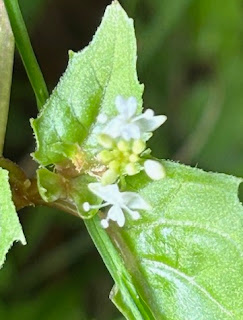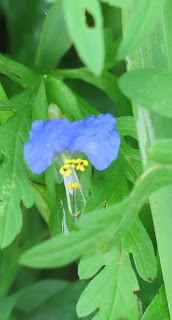Welcome
To all those interested in the natural world. Please add your sightings.
In the woods we return to reason and faith-Emerson
Best-Lynn
In the woods we return to reason and faith-Emerson
Best-Lynn
Sunday, June 30, 2024
6-30 Blue Vervain, Showy Tick Trefoil, Whorled Milkwort, Spiked Lobelia
6-30
Moist thickets, shores and meadows are home to Blue Vervain.
Showy Tick Trefoil - one of 9 Tick Trefoils found in the Northeast - is starting its flowering.
Whorled Milkwort - now in flower - is tiny, obscure and rare.
Spiked Lobelia is common in woods and fields. It seems to particularly favor old log landings and skid roads. John
Saturday, June 29, 2024
6-29 Ditch Stonecrop, Common Evening Primrose, Swamp Milkweed, Buffalo Tree Hopper nymph
6-29
The rather unremarkable yellowish-green flowers of Ditch Stonecrop. can be seen in swamps, ditches and other wet habitats.
Common Evening Primroses are lifting above fields and along roadsides.
Swamp Milkweed - a Monarch butterfly favorite - graces swamps, wet meadows and shores.
A tiny, green nymphal stage Buffalo Tree Hopper displays a bizarrely Seussian, spine fringed silhouette, one best seen with magnification.
John
Friday, June 28, 2024
6-28 Spotted Knapweed, Bouncing Bet, Wild Lettuce
6-28
The thistle-like flower heads of Spotted Kanpweed dot roadsides and waste places - often railroad ballast.
Bouncing Bet, AKA Soapwort, is a common roadside flower. The sap produced when this plant is crushed foams and was once used as a soap substitute.
The plentiful small yellow flowers of Wild Lettuce can be seen in open places although they may be as much as 10 feet off the ground.
John
Thursday, June 27, 2024
6-27 Purple-headed Sneezeweed, Indian Pipes, Ural False Spirea
6-27
The three-lobed flower rays of Purple-headed Sneezeweed make it easy to identify. This species is introduced from further south.
Indian Pipe, AKA Corpse Plant, is a chlorophyll-less woodland dweller.
Rhizomatous, colony-forming Ural False spirea takes over old fields, house sites and riverbanks often to the regret of those who introduced it.
John
Wednesday, June 26, 2024
6-26 Water Hemlock, Pipsissewa, Canada Lily
6-26
Swamps and low meadows are home to Water Hemlock, AKA Spotted Cowbane, all parts of which are deadly poison.
Waxy white or pink flowers and whorled, shiny, evergreen leaves make Pipsissewa easy to identify. Look for it in dry woods and on mossy banks.
The nodding flowers of Canada Lily, AKA Meadow Lily or Wild Yellow Lily, lift above meadows and swamps. Flowers may be yellow, orange or nearly brick red.
John
Tuesday, June 25, 2024
6-25 White Vervain, Purple Loosestrife, Spiny-leaved Sow Thistle, Swamp Candles
6-25
The flower spikes of White Vervain are described as, "slender and more or less interrupted." Look for it in thckets and waste places.
Purple Loosestrife is an aggressive invasive of swamps and wet meadows.
Spiny-leaved Sow Thistles are a common dry roadside plant.
The flowers of Swamp Candles, AKA Yellow Loosestrife, are in a terminal raceme. As the name implies this loosestrife favors swamps and wet ditches.
John
Monday, June 24, 2024
6-24 Wild Radish, Fringed Loosestrife, Enchanter's Nightshade, Dwarf Enchanter's Nightshade, Doe and Fawn
6-24
Wild Radish appears in fields and waste places.
Fringed Loosestrife which has long hair-fringed leaf stalks favors wet meadows and shores.
Racemes of tiny white flowers grace both Enchanter's Nightshade and Dwarf Enchanter's Nightshade plants of moist woods and similar habitats.
A doe and fawn paused just long enough for me to snap a picture. both seemed very bothered by biting insects perhaps deer flies.
John
Sunday, June 23, 2024
6-23 Bracted Plantain, Asiatic Dayflower, Small Green Rain-orchis
6-23
Bracted Plantain is said to favor dry sandy soils. I find it in gravel parking lots.
Asiatic Dayflower - a garden escape - likes moist shady places, often around old home sites.
Cobbly, seepy river shores and wet meadows are home to Small Green Rain-orchis, a protected species.
John
Saturday, June 22, 2024
6-22 Marsh Hedge Nettle, Musk Mallow, Pokeweed
6-22
Marsh Hedge Nettle, AKA Woundwort, - a member of the mint family - favors low meadows, swamps and shores.
Waste places and roadsides are home to Musk Mallow, another alien species.
Moist thickets are home to Pokeweed the shoots of which are edible when young.
John
Friday, June 21, 2024
6-21 Moth Mullein, Butter-and-Eggs, Double-flowered Meadowsweet
6-21
Fields and roadsides are home to Moth Mellein which may be either white or yellow.
Aptly named Butter-and-Eggs is starting its flowering.
Double-flowered Meadowsweet, an alien and sometimes troublesome invasive, adds a touch of pure white to wet thickets.
John
Thursday, June 20, 2024
6-20 Queen Anne's Lace, Swamp Milkweed Beetle, Canada Thistle
6-20
Wild Carrot, AKA Queen Anne's Lace or Bird's Nest, is dotting dry fields and waste places with flat topped umbels of white flowers.
A Swamp Milkweed Beetle was feeding unsurprisingly on Swamp Milkweed.
Canada Thistle is described in my field guide as "a bad weed of pastures and waste places." Creeping underground stems make it a hard plant to eradicate.
John
Wednesday, June 19, 2024
6-19 Heal-all, Day Lily, Monkey Flower, Bean Leaf Beetle
6-19
Heal-all, a very common weed of lawns, fields and roadsides, has dense heads of purplish or sometimes almost white flowers.
Day Lilies - escapes from cultivation - decorate roadsides and old house sites.
Wet places are home to Monkey Flower, so called because its flowers are thought by some to resemble simian faces.
A Bean Leaf Beetle (Certoma trifurcata) fed happily on Showy Tick Trefoil, a member of the pea family.
John
Tuesday, June 18, 2024
6-18 Spotted Touch-me-not, New Jersey Tea
6-18
The dangling long-spurred flowers of Spotted Touch-me-not can be seen in moist often shaded locations.
The dense long-stalked flower clusters of New Jersey Tea dot dry woods and rocky banks.
John
Monday, June 17, 2024
6-17 Shinleaf, Wild Basil
6-17
The nodding waxy flowers of Shinleaf, a Pyrola, sprinkle woodlands and shady edges.
Pink flowers growing out of bristly clusters of bracts make Wild Basil easy to identify. Look for it in weedy borders.
John
Sunday, June 16, 2024
6-16 Japanese Spirea, Shining Ladies Tresses, Winterberry, Racoons
6-16
Introduced Japanese Spirea ocassionally escapes to roadsides and thickets.
Shining Ladies Tresses - formerly Wide-leaved Ladies Tresses - can be found in moist calcerous soils.
Winterberry, AKA Black Alder, is flowering. This shrub is in the holly family.
Racoons are introducing young to the greater world and this one is certainly not happy having a deer so close to her 3 youngsters. Litter size ranges from 1 to 7 for these scrappy little omnivores.
John
Subscribe to:
Comments (Atom)





















































